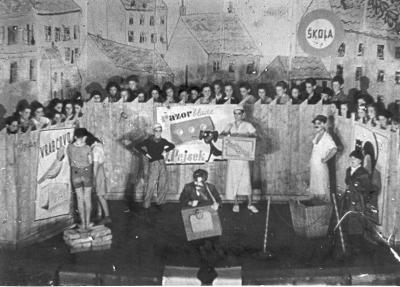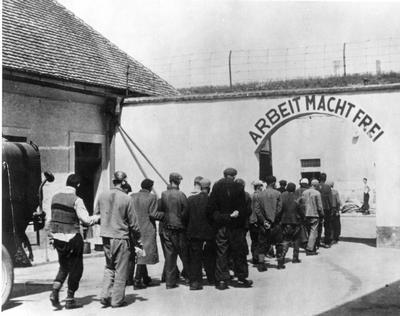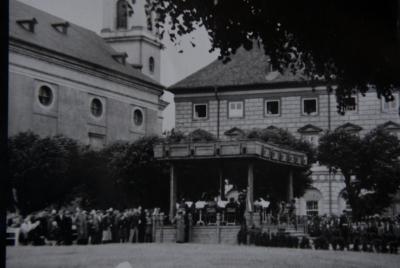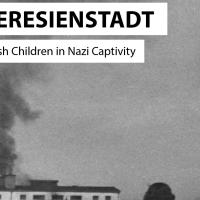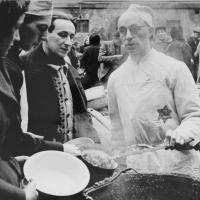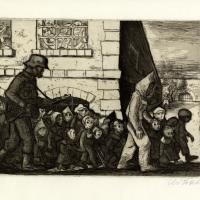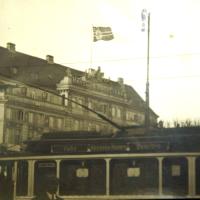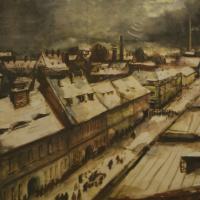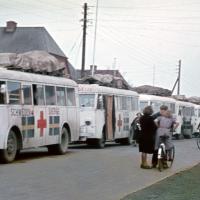Culture, Music and Propaganda
Theresienstadt has been especially known for the camp’s rich cultural life. Since many of the prisoners were artists, there were theatre and opera performances and concerts. For the prisoners who performed in or attended the performances, they offered/were a break in the grey and bleak existence in the camp.
Cultural life
“The barracks, the dancing shadows up and down the walls of the buildings, the grey delivery stations for soup and half-rotten potatoes, the elderly people standing in line for a bowlful of mercy, the shiny cold train tracks and the barred freight cars: everything dissolves. Even the locomotives’ sorrowful whistle fades away. The picture of the bandstand that still remains on the retina fades. Instead, I see in my mind’s eye a springtime meadow trickling and gurgling and bursting with green: The tones of the violins spring out and rise from a succulent green hill like a whitish column of smoke up toward the heavens, whose vault becomes a deeper and deeper blue...”
Part of the cultural life was used for propaganda purposes: A group of painters, for example, were forced to paint pictures of life in Theresienstadt that did not reflect reality at all. When it was discovered that they had secretly also portrayed the real conditions and smuggled their drawings out of the camp, they were imprisoned in the Small Fortress and tortured. Only one painter survived.
Some prisoners in the camp were musicians, conductors or composers, and several orchestras were established in Theresienstadt. Paul Aron, who played the trumpet, was a member of one orchestra. He had learned to play in the Tivoli Guard in Copenhagen, and in Theresienstadt he played with adult musicians who had formerly played in Europe’s symphony orchestras.
The Small Fortress
The Small Fortress is located next to the town of There-sienstadt, which is some-times referred to as the the Large Fortress. From the summer of 1940 the Small Fortress became 'Gestapo Prison Prague'. This meant that political prisoners and opponents of the Nazi regime were imprisoned here. Prisoners from the ghetto could be also sent to the Small Fortress as punishment.
The ‘beautification’ program
In spring 1944, a large-scale program to beautify Theresienstadt was initiated. Representatives from the Red Cross and the Danish administration were visiting the camp. Visiting the Danish prisoners in Theresienstadt was part of the agreement between Adolf Eichmann and Werner Best. The Nazis wanted the camp to look good for the visit, and therefore initiated the beautification program.
In May 1944, about 7500 people were deported to Auschwitz to make the camp seem less crowded. Everything that was to happen during the visit was rehearsed, so that the guests would be convinced that the camp was a nice place. Buildings were painted, grass planted, and everything was cleaned. A bandstand was built, where the orchestra could play, and the fence that had previously separated the Jews’ area from the SS’s area was removed. A Danish prisoner who experienced the beautification program described it in this way:
“Theresienstadt expected a visit by a commission from the Danish Red Cross and the Danish Foreign Ministry, and a film was even planned to depict life in Theresienstadt. So the whole ghetto had to be made beautiful: The order was called CITY BEAUTIFICATION! The Jews built playgrounds with swings and sandboxes for the small children; grass and flowers were planted on the square. The grass seed came from Denmark! And all the streets were washed with soap and water. The sidewalks should be so clean that you could lick them! The women were on their knees in the street and scrubbed with all their might; also the dirt roads. Woe to the one who left a dirty spot.”
23 June 1944
The Red Cross delegation arrived on 23 June 1944. The sun shone brightly, and Theresienstadt looked like a fine little town. The shop windows were full of products; it was just not apparent that the prisoners were not allowed to buy them. On this day the meals were served in a large dinning room, and the prisoners were allowed to eat until they were full. The children played in the children’s pavilion that had been built for the visit and which was dismantled again shortly afterwards. For many prisoners, hard work was for this special occasion replaced with a walk in the new park, a visit to a café and a concert. Nothing, however, was left to chance but rehearsed in every detail.
The visit
Paul Eppstein, Theresienstadt’s ‘Elder of the Jews’ at that time, was dressed up as mayor for the occasion. He received the Red Cross delegation – a Swiss doctor representing the International Red Cross and a Danish doctor representing the Danish Red Cross, as well as a Danish official from the Foreign Ministry. Some German SS officers and a delegate from the German Red Cross also participated. Paul Eppstein had been ordered to show the delegation around the camp. They visited the square where music was being played, the children’s pavilion in the park, and a house where some of the Danish families lived.
The SS leadership had threatened to transport the Danish Jews if they revealed the real conditions in the camp to the guests. The SS was actually so worried about a potential leak that some prisoners were locked in an attic during the visit.
New housing
Just before the Red Cross visit, some Danish families were allowed to move together into rooms that were nicely furnished with newly made furniture and potted plants in the windows. The Red Cross delegation was to believe that everyone in Theresienstadt had a proper place to live:
“The prominent Danes were moved to a completely new-renovated house with a low percentage of inhabitants per room. A few days before the delegation’s arrival I am standing in a machine shop producing wooden legs for tables and chairs and thinking: The commission must be able to smell that this furniture is brand new, since it smells so freshly of pine.”
The Danish Chief Rabbi, Friediger, has described one of the houses where the Danes lived:
“At the beginning of June, the Danish colony received four houses, where a number of Danes were able to enjoy some private family life. This was the greatest privilege that had ever been given the ghetto residents. In one of the houses, Seestrasse 22, there was a three-windowed room not to be used as sleeping quarters by the residents. It was furnished with two tables, benches and chairs, plants on the table and pictures on the walls! A living room for the Danes!”
Those families who moved into the ‘nice’ houses were allowed to live there until the Red Cross visit was over.
The report
Apparently, the Nazis succeeded in fooling the delegation with this elaborate propaganda stunt. In any case, all three delegates wrote positive reports about the visit. After the war, the Danish representatives explained that they had indeed realized that much of what they saw was staged, but they had decided to keep it to themselves in order to protect the Danish prisoners against possible German reprisals. Whether this is the truth, a rationalization or bad conscience is difficult to determine today.
Propaganda film
The play that was performed in Theresienstadt in the late summer day of 1944 was captured in a propaganda film in which also Danish prisoners were forced to participate. When filming was completed in the fall of 1944, most of those involved – although not the Danes – were deported to Auschwitz, where they were murdered in the gas chambers.
